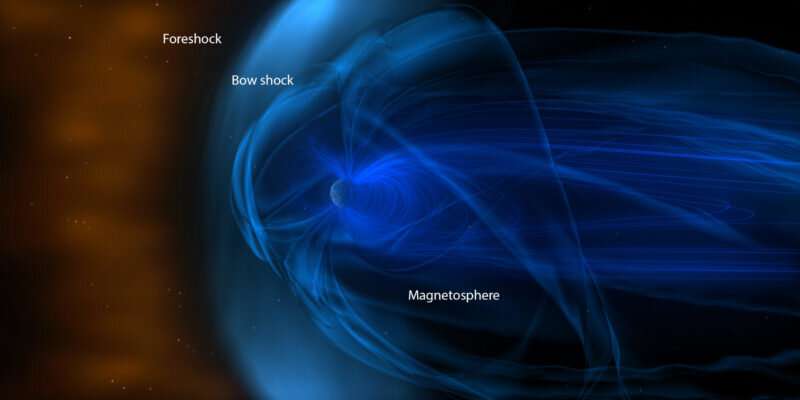Surfing space dust bunnies spawn interplanetary magnetic fields

A 40-year-old enigma about ghostly magnetic fields in interplanetary space may have finally been solved by new data from a constellation of 12 satellites in near-Earth space.
New research
in the AGU journal Geophysical Research Letters finds that
If the discovery is correct, it points to a new way to study the little-understood intersection between the realms of the very big things in our solar system—like asteroids and planets—and the very smallest particles. Among other things, it could help explain how the Sun and other stars clean their interplanetary households.
"This event is important not only because it has been observed by so many satellites on one occasion, but also because it has been traced from the interplanetary space to the terrestrial magnetosheath," explained planetary scientist Hairong Lai of Sun Yat‐Sen University, Zhuhai, China, who is the lead author of the new paper. The magnetosheath is the piled up solar wind created behind the bow shock, the region where the wind encounters the Earth's magnetic field. Seeing the magnetic event in both space environments put their dust model to the test.
Magnetic mystery
The mystery started in 1982 when spacecraft in interplanetary space near Venus and equipped with a magnetic field sensor—called a magnetometer—detected a 12-hour-long change in the local magnetic field. The magnetic field change was inexplicable because there was no obvious cause.
"The magnetometer detected that the magnetic field started rising, then got stronger and stronger, then dropped and flattened out," said planetary scientist Christopher Russell of the University of California at Los Angeles, who remembers the event and is a co-author of the new study. I thought it was a comet passing by. That was totally wrong. I had no physical feeling for what this was."
In the years since, Russell and other scientists recorded more such magnetic events by spacecraft, lasting anywhere from a few seconds to 12 hours. He and his colleagues developed a hypothesis that they were caused by clouds of magnetized dust surfing the solar wind.
"We came up with the idea that these were dust bunnies made by colliding rocks in space," he said.
The collisions annihilated the rocks and left dust particles small enough that they could be zapped and ionized by ultraviolet radiation from the Sun. Once they were ionized—which means they were given an electrical charge—they could be affected by the electrical charges of the much smaller, but much faster, particles blowing out from the Sun in the solar wind. The dust could then be dragged along by the solar wind, gradually gaining speed, like a surfer catching a wave. As long as the dust was slower than the solar wind, the dust particles would cause a dent in the local magnetic field, which is what the spacecraft magnetometers detect sweeping past them.
"We've had trouble finding a piece of evidence to convince everyone that this is the right model," said Russell.
Digging through data
To test the model, Lai searched satellite magnetometer data records to find other events. What she found was an event on 16 January 2018 that was detected by a dozen spacecraft. But better than that, the dust cloud passed from interplanetary space and into Earth's magnetosheath, which is much more revealing.
Their hypothesis, Lai explained, is that upstream of Earth's magnetic bow shock, the solar wind is faster than the dust, and drags the slower dust along with it. Downstream of the bow shock, however, the solar wind is slowed down and the dust isn't. The roles reverse and the dust drags the solar wind in the magnetosheath.
By comparing how the magnetic fields changed on the twelve spacecraft both upstream and within the magnetosheath, Lai and her colleagues could test that hypothesis. What they found was a pattern of magnetic field changes that matched their ionized dust hypothesis in both space environments.
In addition to solving a mystery, the new observations provide insights into the behavior of neutral matter in the solar system—like rocks, asteroids and planets—and charged matter like plasma, Russell said.
"The (scientific) community doesn't really think about the interface between neutral rocks and plasma," he said. When particles are small enough, that neutral matter becomes charged and is affected by the solar wind. "This is showing where that interface is."
More information: H. R. Lai et al. Magnetized Dust Clouds Penetrating the Terrestrial Bow Shock Detected by Multiple Spacecraft, Geophysical Research Letters (2019). DOI: 10.1029/2019GL085818
Journal information: Geophysical Research Letters
Provided by American Geophysical Union
This story is republished courtesy of AGU Blogs (http://blogs.agu.org), a community of Earth and space science blogs, hosted by the American Geophysical Union. Read the original story here.





















